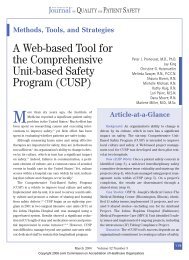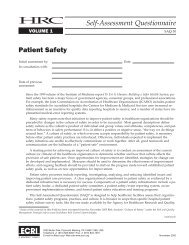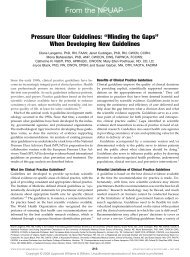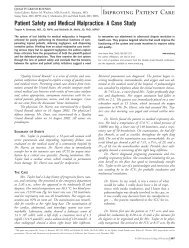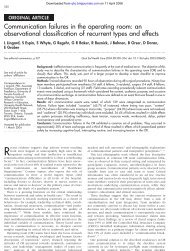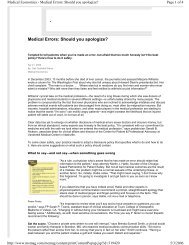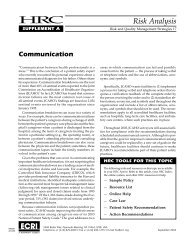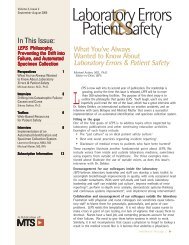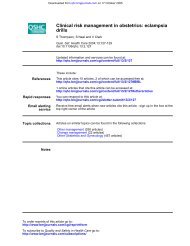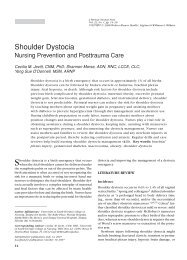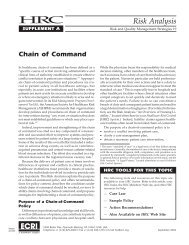Issue Brief - MCIC Vermont Patient Safety Documents
Issue Brief - MCIC Vermont Patient Safety Documents
Issue Brief - MCIC Vermont Patient Safety Documents
Create successful ePaper yourself
Turn your PDF publications into a flip-book with our unique Google optimized e-Paper software.
Medical Errors: Five Years After the IOM Report 1110Institute of Medicine. 1999. To Err Is Human:Building a Safer Health Care System. Washington, DC:National Academies Press.11Ibid.12The report recommended that adverse event reportingshould initially be required of hospitals and eventuallymandatory for other institutional and ambulatorydelivery systems.13Institute of Medicine. 1999. To Err Is Human:Building a Safer Health Care System. Washington, DC:National Academies Press.14AHRQ’s <strong>Patient</strong> <strong>Safety</strong> Initiative: Building Foundations,Reducing Risk. Interim Report to the Senate Committeeon Appropriations. AHRQ Publication No.04-RG005. December 2003. Agency for HealthcareResearch and Quality, Rockville, MD. Retrievedfrom: http://www.ahrq.gov/qual/pscongrpt/.15Fact Sheet: Improving <strong>Patient</strong> <strong>Safety</strong> and PreventingMedical Errors. 2002. United States Department ofHealth and Human Services. http://www.hhs.gov.news/press/2002pres/safety.html.16Learning from Mistakes: Toward Error-FreeMedicine. 2004. Investigator Awards in Health Policy:Research in Profile. 11: 1-4.17Making Health Care Safer: A Critical Analysis of<strong>Patient</strong> <strong>Safety</strong> Practices. 2001. Evidence Report/Technology Report: Number 43. Agency for HealthCare Quality.18Fact Sheet: Improving <strong>Patient</strong> <strong>Safety</strong> and PreventingMedical Errors. 2002. United States Department ofHealth and Human Services. Retrieved from:http://www.hhs.gov.news/press/2002pres/safety.html.19PQIs were released in November 2001. IQIs werereleased in May 2002. PSIs were released in March2003. See: http://www.qualityindicators.ahrq.gov/index.htm.20Prevention Quality Indicators Overview. AHRQQuality Indicators. 2004. Agency for HealthcareResearch and Quality, Rockville, MD. Retrievedfrom: http://www.qualityindicators.ahrq.gov/pqi_overview.htm.21Inpatient Quality Indicators Overview. AHRQQuality Indicators. 2004. Agency for HealthcareResearch and Quality, Rockville, MD. Retrievedfrom: http://www.qualityindicators.ahrq.gov/iqi_overview.htm.22<strong>Patient</strong> <strong>Safety</strong> Indicators Overview. AHRQ QualityIndicators. 2004. Agency for Healthcare Research andQuality, Rockville, MD. Retrieved from:http://www.qualityindicators.ahrq.gov/psi_overview.htm.23As of October 2004, there were 2,612 downloads ofthe IQI software, 1,760 downloads of the PQI software,and 2,006 downloads of the PSI software. As afederal agency, AHRQ is limited in the ways it canobtain and track information about users of qualityindicators. Therefore, only limited case studies andanecdotal information is available about specific usesof the QIs. Conversation with Dr. Denise Remus,Senior Research Scientist, AHRQ.24Lamb, R.M. et al. 2003. Hospital Disclosure Practices:Results of a National Survey. Health Affairs. 22: 73-83.25Gallagher, T.H. et al. 2003. <strong>Patient</strong>s’ and Physicians’Attitudes Regarding the Disclosure of MedicalRecords. JAMA. 289 (8): 1001–1007.26Robinson, A.R. 2002. Physician and Public Opinionon Quality of Health Care and the Problem ofMedical Errors. Archives of Internal Medicine. 162:2186–2190.27Roscoe, L.A. et al. 2002. Reporting Medical Errors:Variables in the System Shape Attitudes TowardReporting Adverse Events. Bulletin of the AmericanCollege of Surgeons. 87 (9): 12–17.28Finkelstein, J.B. July 2004. Senate Passes <strong>Patient</strong> <strong>Safety</strong>Bill with New Error Reporting System. Retrievedfrom: http://www.ama-assn.org/amednews/2004/08/09/gv110809.htm.29Williams, L.K. et al. 2003. Differences in theReporting of Care-Related <strong>Patient</strong> Injuries to ExistingReporting Systems. Joint Commission Journal on Qualityand <strong>Safety</strong>. 29: 460–467.30States with mandatory reporting systems: CO, FL, KS,MA, NE, NJ, NY, OH, PA, RI, SC, SD, TN, TX, WA.States with voluntary reporting systems (including theDistrict of Columbia): DC, GA, NC, NM, OR, WY.See: Rosenthal, J. et al. 2000. State Reporting of MedicalErrors and Adverse Events: Results of a 50-State Survey.Portland, ME: National Academy for State HealthPolicy.



